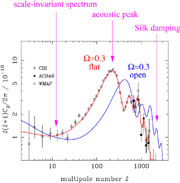


7.3. Characteristic scales
The current data are contrasted with some CDM models in
figure 17. The key feature that is picked out
is the peak at 
 220, together with
harmonics of this
scale at higher
220, together with
harmonics of this
scale at higher  .
Beyond
.
Beyond 
 1000, the spectrum
is clearly damped, in a manner consistent with the expected
effects of photons diffusing away from baryons (Silk damping),
plus smearing of modes with wavelength comparable to the
thickness of the last-scattering shell. This last effect
arises because recombination is not instantaneous, so the
redshift of last scattering shows a scatter around the mean,
with a thickness corresponding to approximately
1000, the spectrum
is clearly damped, in a manner consistent with the expected
effects of photons diffusing away from baryons (Silk damping),
plus smearing of modes with wavelength comparable to the
thickness of the last-scattering shell. This last effect
arises because recombination is not instantaneous, so the
redshift of last scattering shows a scatter around the mean,
with a thickness corresponding to approximately
 r =
7(
r =
7( m
h2)-1/2 Mpc. On scales larger
than this, we see essentially an instantaneous imprint
of the pattern of potential perturbations and the
acoustic baryon/photon oscillations.
m
h2)-1/2 Mpc. On scales larger
than this, we see essentially an instantaneous imprint
of the pattern of potential perturbations and the
acoustic baryon/photon oscillations.
 |
Figure 17. Angular power spectra
|
The significance of the main acoustic peak
scale is that it picks out the (sound) horizon at last scattering.
The redshift of last scattering is almost independent of
cosmological parameters at zLS
 1100, although a more
precise approximation is given in Appendix C of
Hu & Sugiyama (1995).
If we assume that the universe is matter dominated at
last scattering, the horizon size is
1100, although a more
precise approximation is given in Appendix C of
Hu & Sugiyama (1995).
If we assume that the universe is matter dominated at
last scattering, the horizon size is
 |
(145) |
The angle this subtends is given by dividing by the current size of the horizon (strictly, the comoving angular-diameter distance to zLS). Again, for a matter-dominated model, this is
 |
(146) |
This expression lies behind the common statement that
the CMB data require a flat universe. Figure 17
shows that heavily open universes yield a main CMB peak at scales much
smaller than the observed 
 220, and these can be
ruled out. Indeed, open models were disfavoured for this reason long
before any useful data existed near the peak, simply
because of strict upper limits at
220, and these can be
ruled out. Indeed, open models were disfavoured for this reason long
before any useful data existed near the peak, simply
because of strict upper limits at

 1500
(Bond & Efstathiou
1984).
However, once a non-zero vacuum
energy is allowed, the story becomes more complicated,
and it turns out that large degrees of spatial curvature
cannot be excluded using the CMB alone.
1500
(Bond & Efstathiou
1984).
However, once a non-zero vacuum
energy is allowed, the story becomes more complicated,
and it turns out that large degrees of spatial curvature
cannot be excluded using the CMB alone.